Transient voltage suppressor TVS for automotive electronic system protection
Central issue:
This article refers to the address: http://
- TVS parameter analysis for automotive electronic protection
- TVS is applied to automotive electronics protection solutions
solution:
- TVS for primary protection of automotive power cords
- TVS protection against negative transient voltages and reverse supply voltages
- TVS for secondary protection of automotive power cords
A major challenge in automotive design is to protect electronic devices (such as control units, sensors, and infotainment systems) from harmful surge voltages, transient voltages, ESD, and noise on power lines. Transient Voltage Suppressors (TVS) are ideal for automotive electronic protection, and some of their parameters are important for these applications, including rated power, off-state voltage, breakdown voltage, and maximum breakdown voltage. Below are the definitions of these parameters.
rated power
The rated power of a TVS is the ability to absorb surges under certain test or application conditions. The industry standard test conditions for the 10 μs/1000 μs pulse waveform (Bellcore 1089 standard) are shown in Figure 1. This test condition is different from the TVS transient voltage absorption capability test condition of the 8μs/20μs pulse waveform, as shown in Figure 2.
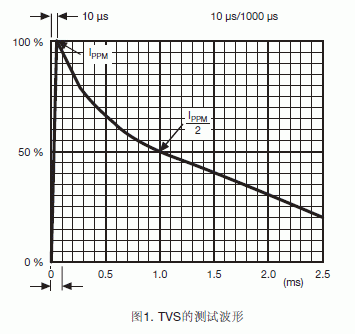

Breakdown voltage (VBR)
The breakdown voltage is the voltage at which the device enters the avalanche breakdown and is tested under specific current conditions on the data sheet (Figure 3).
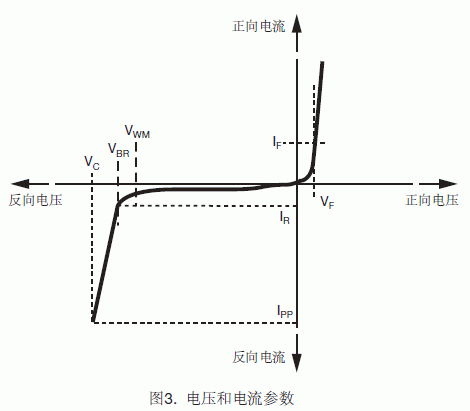
Maximum breakdown voltage (VC: clamp voltage)
The clamp voltage appears on the TVS at a specific peak pulse current rating. The breakdown voltage of the TVS is measured at very low currents (eg 1 mA or 10 mA), which is different from the actual avalanche voltage under application conditions. Therefore, semiconductor manufacturers are labeling typical or maximum breakdown voltages at high currents.
Off-state voltage (VWM): reverse off-state operating voltage
The off-state voltage refers to the highest voltage that the TVS can withstand without breakdown. It is an important parameter for protecting the device in a non-operating circuit under normal conditions. In the car, some automotive electronics specifications are based on the "jumper jumper start protection" situation. This situation requires a 10V 24VDC for a 12V type electronic device or a 10 minute 36VDC for a 24V type electronic device without damaging the circuit or causing a circuit failure. Therefore, the off-state voltage is a key parameter of TVS in automotive electronics.
Automotive power cord primary protection (load dumping)
Automotive electronics such as electronic control units, sensors and infotainment systems are connected to a power line (Figure 4). The power supplies for these electronic products are batteries and alternators, both of which have unstable output voltages and are susceptible to temperature, operating conditions, and other conditions. In addition, automotive systems that use electromagnetic coil loads such as fuel injection systems, valves, motors, electrical and hydrolysis controllers introduce ESD, spike noise and other types of transient and surge voltages into the power and signal lines.
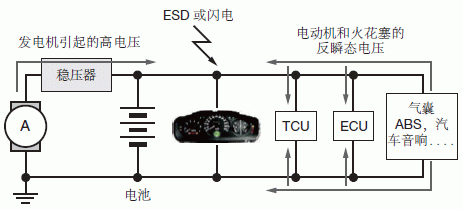
Figure 4: Typical car power cord.
What is load shedding?
The worst surge voltage occurs when the battery is disconnected while the engine is running. When the alternator supplies current to the car's power line, this is called "load dumping." Most automakers and industry associations will set the maximum voltage, line impedance, and duration of this load shedding state for this load shedding state, as shown in Figure 5. The load impedance of the load rejection is higher than the power supply impedance during normal transient testing. Because the battery is disconnected and only the generator is outputting power outward, the internal coil of the alternator is equivalent to a current limiting resistor.
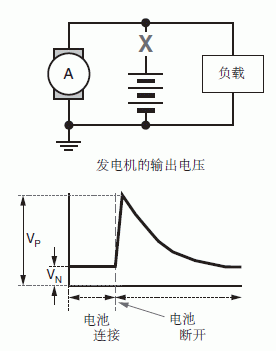
Figure 5: Output voltage of the alternator during load shedding.
In the process of load shedding, it is necessary to consider the dynamic performance of the alternator: under the load shedding condition, the internal resistance of the alternator is mainly a function of the alternator speed and the excitation current. Calculate the relationship of the internal resistance Ri of the load test pulse generator: Ri = (10 × Unom × Nact) / (0.8 × Irated × 12,000min-1), where Unom is the rated voltage of the alternator, Irated is the AC The rated current of the generator speed is 6000min-1 (given by ISO 8854), and Nact is the actual alternator speed in min-1.
Two well-known tests simulate this condition: US ISO-7637-2 Pulse 5 for 14V powertrain and JASO A-1 for Japan and JASO D-1 for 27V powertrain. In this section, we will review TVS applications for load shedding in 14V powertrains.
Load rejection test specifications and results
The US ISO-7637-2 Pulse 5 and Japanese JASO A-1 test simulations for the 14V powertrain are shown in Table 1 and Figure 6.

Table 1: JASO A-1 and ISO-7637-2 Pulse 5 test simulation conditions. 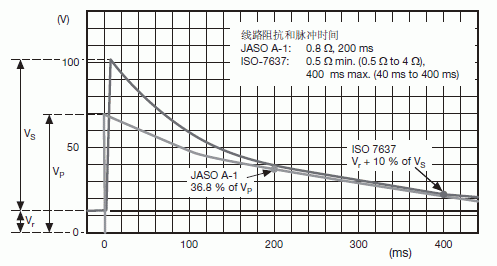
Figure 6: For the ISO-7637-2 test conditions, the standard VS and Ri values ​​range from 65V to 87V and 0.5Ω to 4Ω, respectively.
Some car manufacturers have adopted different conditions for the load shedding test based on ISO-7637-2 Pulse 5. The formula for estimating the peak clamp current of the load-shedding TVS is IPP=(Vin–VC)/Ri, where IPP is the peak clamp current, Vin is the input voltage, VC is the clamp voltage, and Ri is the line impedance.
In the 87V supply voltage (Vs), 13.5V battery voltage (Vbatt.), 0.75Ω Ri and 400ms ISO-7637-2 test, Vishay's SM5S24A current and voltage waveforms are shown in Figure 7A.
In Figure 7B, in the ISO-7637-2 test of 87V VS, 13.5V Vbatt., 0.5Ω Ri, and 400ms pulse width, the clamp voltage and current of the load dump TVS are disabled because the device is dissipated too much. The clamp voltage drops to near zero and the current flowing through the device rises to the maximum allowed by the line impedance.
The maximum clamping performance of Vishay load-shedding TVS is shown in Figure 7C under ISO-7637-2 pulse 5 test conditions with 13.5 V Vbatt and 400 ms pulse width. In order to prevent the failure in Figure 7B from occurring, it is necessary to fully consider the maximum quota of the TVS.

Figure 7A: Clamping voltage and current of the SM5S24A in the ISO 7637-2 test. Figure 7B: Clamping voltage and current for a dead load TVS failure in the ISO 7637-2 test. Figure 7C: Maximum clamp performance of Vishay load-bearing TVS in the ISO 7637-2 test.
Protection against negative transient voltages and reverse supply voltages
There are two types of load dump TVS for automotive electronic primary protection: epitaxial and non-epitaxial. In the reverse bias mode, the two sets of products have similar breakdown characteristics. The difference is that the epitaxial TVS has a low forward voltage drop (VF) characteristic in the forward mode, and the non-epitaxial TVS has a relatively high VF under the same conditions. This feature is important for the reverse voltage applied to the power line. Most CMOS ICs and large scale integrated circuits (LSIs) have poor reverse voltage characteristics.
The gate of the MOSFET is also vulnerable at a reverse voltage of -1V or lower. In the reverse power input mode, the power line voltage is the same as the TVS VF. This reverse bias mode can cause electronic circuit failure. The low forward voltage drop of the epitaxial TVS can solve this problem well. Another way to protect the circuit from reverse power input is to use a polarity-protected rectifier on the power line, as shown in Figure 8. The polarity protection rectifier should have sufficient forward current rating and forward surge and reverse voltage performance.

Figure 8: Secondary protection circuit.
Secondary protection of the car's power cord
The primary object of the protection circuit in automotive systems is high surge voltage, but the voltage clamped is still high. Therefore, secondary protection in 24V powertrains is particularly important, such as powertrains in trucks and trucks. The main reason is because the maximum input voltage of most regulators and DC-DC converter ICs is 45V~60V. For such applications, the secondary protection in Figure 9 is recommended.
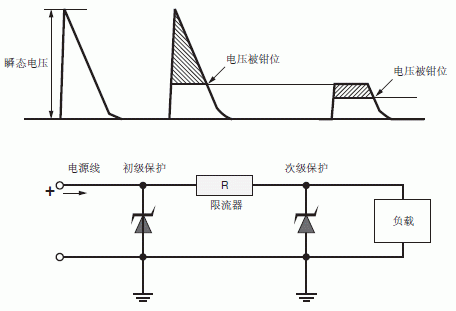
Figure 9: Reverse biased state.
Adding a resistor R to the power line reduces the transient current so that a smaller rated power TVS can be used as a secondary protection. The microcontroller and logic in the electronic unit require a current of 150 mA to 300 mA. The minimum output voltage of the 12 V battery at -18 ° C is 7.2 V. Under the same conditions, the minimum output voltage of the 24 V battery is 14.4 V. In the same condition of the 24V battery, the power supply voltage is 8.4V under the condition of 300mA load and R=20Ω, and 11.4V under the condition of the lowest voltage of R=10Ω and 14.4V (the voltage of the 24V battery at -18°C). The calculation formula is: VL=(Vmin/(Vmin/IL))×((Vmin/IL)–R), where VL is the load voltage, Vmin is the minimum input voltage, IL is the load current, and R is the resistance value. R rated power = I2R.
For most regulators and DC/DC converter ICs, the supply voltage is higher than the minimum input voltage to avoid circuit faults caused by low voltage inputs.
Safety and reliability are also very important considerations in automotive systems, but they are beyond the scope of this article.
7.1 Home Theater Speaker is the common name for an eight-channel surround Audio System commonly used in home theatre configurations. It adds two additional speakers to the more conventional 5.1 audio configuration. As with 5.1 surround sound, 7.1 Home Theater Speaker System uses the standard front, center, and Subwoofer Speaker configuration. However, whereas a 5.1 Speaker combines both surround and rear channel effects into two channels (commonly configured in home theatre set-ups as two rear surround speakers), a 7.1 Speaker splits the surround and rear channel information into four distinct channels, in which sound effects are directed to left and right surround channels, plus two rear surround channels.In a 7.1 Home Theater Speaker set-up, the surround speakers are placed to the side of the listener's position and the rear speakers are placed behind the listener. In addition, with the advent of Dolby Pro Logic IIz and DTS Neo:X, 7.1 Speaker can also refer to 7.1 surround sound configurations with the addition of two front height channels positioned above the front channels or two front wide channels positioned between the front and surround channels.
7.1 Home Speaker
7.1 Home Speaker,7.1 Home Theater Speaker,7.1 Speaker,7.1 Home Theater Speaker System
Guangzhou J.SUN Electronics Co., Ltd. , https://www.jsunaudio.com
